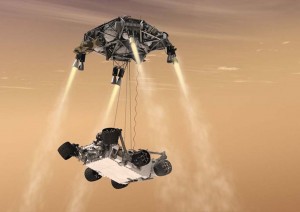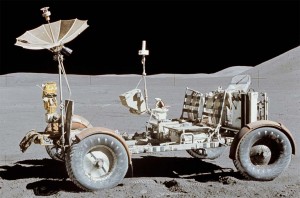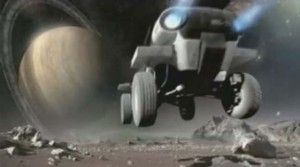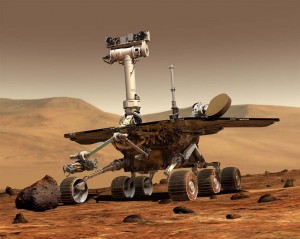He may be “Lightning” Bolt, but Curiosity, the buggy now beginning its two-year mission on Mars, draws its power from 10.6 pounds of plutonium dioxide.
In a week dominated by the Olympics, it has taken a successful mission to the Red Plant, capped by what NASA officials earlier described as “seven minutes of sheer terror” to grab some headlines. The successful, if tricky landing means a 6-legged, unmanned rover packed with science gear might soon be able to offer hints as to whether life once grabbed a tenuous foothold on Mars.
Dubbed Curiosity, it is the most sophisticated in a line of rovers that date back to the days of the Apollo era when astronauts on a series of moon landings were able to extend their range with the help of a lunar equivalent to the dune buggy.
How do the various rovers compare?
The former Soviet Union launched several primitive devices, starting with Lunokhod 1, in 1970. The first rover worked for 11 months, Lunokhod 2 for just four months, sending back pictures and analyzing the soil, but traveling only short distances.
The only manned models ever taken into space were known as the Lunar Roving Vehicles, or LRVs, battery-powered four-wheelers that served Apollo missions 15, 16 and 17. Developed in part by General Motors, they were as stripped down as possible to permit them to be loaded onto a Saturn V for launch, on them to fold up inside a cargo bay inside the Apollo mission’s Lunar Excursion Module, or LEM.
Power was provided by what was, for the time, a highly sophisticated 36-volt silver-zinc potassium hydroxide batteries. They weren’t rechargeable, which didn’t matter on a one-way mission like Apollo. The key was the battery pack’s durability in the moon’s devastating environment. Maximum range was 57 miles, though the longest distance driven was 22.3 miles on Apollo 17 – with the astronauts never getting more than 4.7 miles from their LEM base.
Incidentally, despite a humorous Bridgestone ad that ran last year suggesting moon buggy tires might be worth stealing, regular, inflatable rubber tires wouldn’t have worked in the zero-atmosphere environment. Instead, the LRV’s “resilient wheels” had titanium chevrons, or plates, covering a weave of metal around an aluminum disc.
The Apollo mission ended in 1972 and it took another quarter century before the a rover was again to reach alien soil. In 1997, a 23-pound craft named Sojourner rolled out of a fixed base ship called the Mars Pathfinder. It boasted limited range and functionality, but showed that a vehicle operating somewhat autonomously could extend man’s reach off the planet.
Sojourner was the proof in concept for another rover mission launched into space – or two rovers, to be more precise – in 2003. Dubbed Spirit and Opportunity, these little buggies, not much bigger than the remote controlled cars many hobbyists play with, were heading for a much further destination than the LRVs.
The two crafts landed in January 2004 and were expected to function for just 90 days each. In fact, Spirit continued to roam the Red Planet until getting stuck in a sand pit in 2009. Opportunity continues to operate, roving the surface around Mars’ equator on a series of new missions not even conceived of when it was launched.
The two crafts each boast six legs mounted to what is, for practical purposes, a little boogie board. The design allows the two rovers to skitter over surprisingly large obstacles – though deep sand appears to have been an insurmountable obstacle. Each wheel has its own motor and power is generated from solar panels then stored in a set of batteries – which were originally expected to be the weak links that would give out after 90 days.
While the Apollo’s LRV could move with reasonable haste, Spirit and Opportunity were designed to march forward at barely 2 inches a second. And their early autonomous object-detection software required them to stop ever 10 to 20 seconds to observe the terrain and decide how to proceed next.
While the moon is only a couple seconds away, communicating with Mars takes precious minutes, depending on its position relative to the Earth as it revolves around the Sun. So, like the little skateboards, the big Curiosity lander also had to be designed to make a series of autonomous decisions – starting with its perilous landing.
That Rube Goldberg-like process began with the spacecraft holding the rover turning its head shield into the thin Martian atmosphere at 13,000 miles an hour. As its speed decreased the heat shield was discarded and a massive parachute was deployed. As the craft descended it needed to slow even more, something the chute couldn’t achieve in the thin air so a rocket-powered “backpack” fired up, descending until it was just above the rust-red surface, Curiosity being lowered the rest of the way on a cable. The cord released, the backpack flew off before crashing to the ground.
NASA had good reason to be worried considering a string of other rover-equipped Mars landers, including the Soviet’s Mars 2 and 3, and America’s Beagle 2, crashed as they attempted to land.
After traveling 354 miles over the course of 263 days – at speeds of up to 54,000 mph – Curiosity will now move at a snail’s pace, barely 1.5 inches a second, or less than a tenth a mile per hour. As it has an anticipated range from its landing point of barely 15 miles, that’s probably more than enough.
Though sized somewhere between a Smart fortwo and a Fiat 500, at 129-inches length, the 6-wheeled Mars buggy is as wide as the original Hummer H1, at 109 inches. It measures 87 inches high, or more than a Ford F-150 Raptor pickup. And its total payload is just 88 pounds. Of course, since Mars’ gravity is only 38% of Earth’s, that’s more than you might think.
As with Spirit and Opportunity, the unmanned Curiosity has to operate autonomously. One-way communications times can reach a maximum 13.5 minutes so it would otherwise be impossible to function effectively. But controllers on Earth can upload extensive software commands to get the craft to do their bidding.
Unlike the earlier Mars landers, Curiosity won’t have to worry about keeping its solar panels aimed. The craft uses 10.6 pounds of nuclear fuel to operate its six individually powered wheels, radios, cameras, science lab and a 43.3-inch robotic arm.
While America’s space program may be struggling for budget during the current fiscal belt tightening, few expect Curiosity to be the last rover to leave Earth’s confines:
- The increasingly ambitious Chinese are looking to send the unmanned Chang’e 3 to the moon in 2013;
- India also wants to dig some lunar soil with a mobile craft it calls Chandrayaan-II that is set for a 2014 launch;
- NASA, meanwhile, is exploring several rover projects including the six-legged ATHLETE, or All-Terrain Hex-Legged Extra-Terrestrial Explorer, Scarab and SEV, or the Space Exploration Vehicle.
Beyond that? Perhaps we’ll see something from private industry. Several firms have this year announced interest in mining asteroids. They’ll need some help and a new rover could be the answer.




